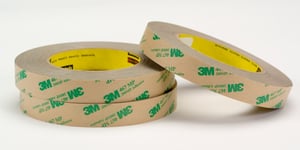You’re steadily making your way through your list of material options when you recall adhesive transfer tape, yet, it’s hard to remember the exact benefit of using it in a project.
The engineers at Strouse have helped build multiple processes that utilize adhesive transfer tapes to create a final product, and having worked with it for many years, we feel customers must understand both the pros and cons before making a choice.
Once you’ve gone through the advantages and disadvantages of adhesive transfer tape, you’ll know enough to decide whether it fits your application.
ADHESIVE TRANSFER TAPE: THIN BONDING
When you think of adhesive transfer tapes, think about flexibility.
The “thinnest” of thin bonding tapes (sub 1 mil), adhesive transfer tapes are conformable to elastic, printed circuit boards, thin plastic, and many other materials, even irregular shapes and sizes. Plus, because they’re so thin, adhesive transfer tapes are perfect for products that need to be aesthetically pleasing.
It takes an experienced converter to handle adhesive transfer tapes properly. The materials themselves and how they’re converted often make for a challenging manufacturing process, which we’ll get into later.
The objects being bonded together (the substrates) and their composition are the determining factors for thin bonding products. Adhesive transfer tape manufacturers offer thousands of transfer tapes. When selecting material, you should discuss product functionality with your converter to help determine that the form meets the function.
How is Adhesive Transfer Tape Made?
Adhesive Transfer Tape (ATT) is a thin adhesive film with a release liner. The liner makes handling easier and peels off when applying to the second substrate.
Unlike double sided tapes, adhesive transfer tapes only have one type of adhesive and no carrier (the material that separates and holds two adhesives). If the product requires its tape to provide a significant stiffness to function correctly, only a tape with a carrier, or double sided tape, will suffice. Suitable adhesive transfer tapes can do the job if the stiffness comes from the bonded materials.
The thinness of transfer tape has design advantages but can also lead to problems in the converting process. Think of a delicate sheet being pulled off a release liner. Too much tension can pull the liner off too easily or break the adhesive, and not enough tension makes the adhesive stay with the liner. There is a fine line when a pressure sensitive adhesive (PSA) tape is so stretchy.
The Advantage of Transfer Tape: Surface and Environment
As previously mentioned, the substrates’ composition helps converters decide what adhesive transfer tape to use. Yet, there are also the surface’s three-dimensional characteristics to consider, which is where transfer tape shines.
In short, these are the advantages and disadvantages of adhesive transfer tape:
ADVANTAGES
- Flexible and conformable to irregular shapes
- Design flexibility and clean aesthetics
- Low profile allows for stacking
- Not limited to the temperature resistance of a carrier
- Optical clarity solutions
- Replace mechanical fasteners
- Converters can combine adhesive transfer tapes with a carrier to make a custom double sided tape
DISADVANTAGES
- Adds no significant stiffness (no carrier)
- Cannot easily bond two dissimilar materials
- Handling strength is minimal
- Thinness requires expert converting
A physical surface is rarely completely flat, yet some surfaces have quite a bit of irregularity and require adhesives with more substantial coverage and surface energy, such as flexible tape without a carrier.
Another advantage of adhesive transfer tapes is their low profile, which allows for easier stacking atop one another to perform different functions. Plus, with no carrier, a transfer tape is not dependent on the carrier’s ability to withstand high temperatures as it is with double sided tape.
Sub-zero temperatures can affect an adhesive solution’s effectiveness as much as hot environments or a tape constantly exposed to the sun’s UV rays or moisture. Many adhesive transfer tape manufacturers perform tests to ensure their adhesive's UV or moisture-resistant capabilities, including 3m adhesive transfer tapes.
If the application demands optical clarity, an optically clear adhesive (OCA) transfer tape is the most appropriate product because of its thinness and minimal construction material used. When looking good is a priority, adhesive transfer tapes replace bulky rivets, bolts, and other mechanical fasteners. An ultra-thin transfer tape is low profile and nearly unnoticeable.
Using Adhesive Transfer Tape in Production
While adhesive transfer tapes are thin and flexible, they’re not very sturdy, so converting them requires expertise. Consistently cutting to exact dimensions or complex shapes at low tensions is not something every converter can do.
For example, if the project involved die cutting shapes in transfer tape, then removing adhesive sections for a tab, not having a carrier in the middle will substantially increase the difficulty of your process.
Experienced engineers at high-end converters have designed processes to ensure that adhesive transfer tapes meet specified dimensions and tolerances while being designed for manufacturability.
Some aspects of transfer tape present unique, surprising challenges, such as storage. If a transfer tape is stored improperly for an extended period, gravity will cause the adhesive to flow down off the release liner, creating a pool of adhesive.
A stretchy adhesive transfer tape will provide opportunities and challenges. Involving your converter’s engineers early on goes a long way in guaranteeing the success of your production.
Are you looking for a particular application? Feel free to seek out more specific information on converting adhesive transfer tape. Otherwise, you’ll find additional guides in our Learning Center on other bonding solutions.
Originally published: March 31, 2021








